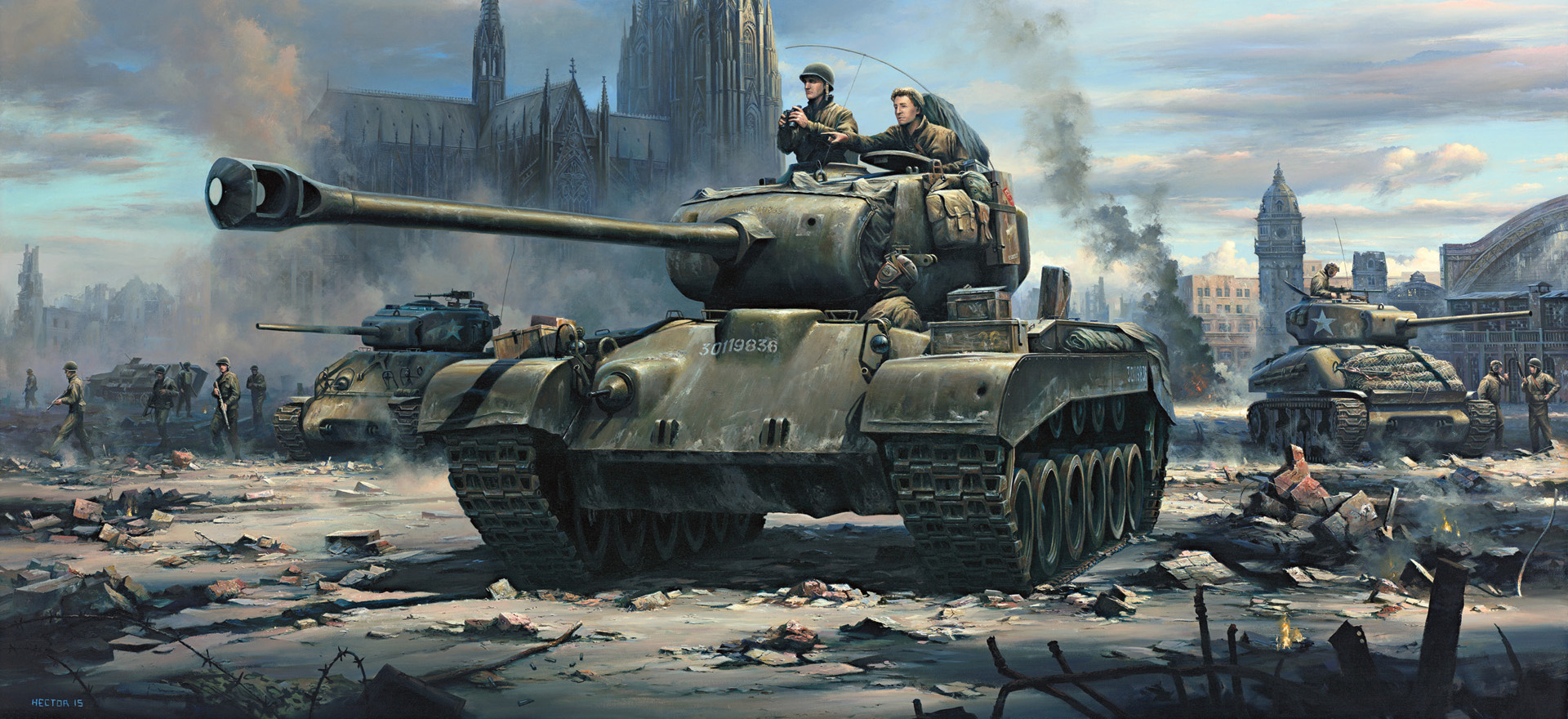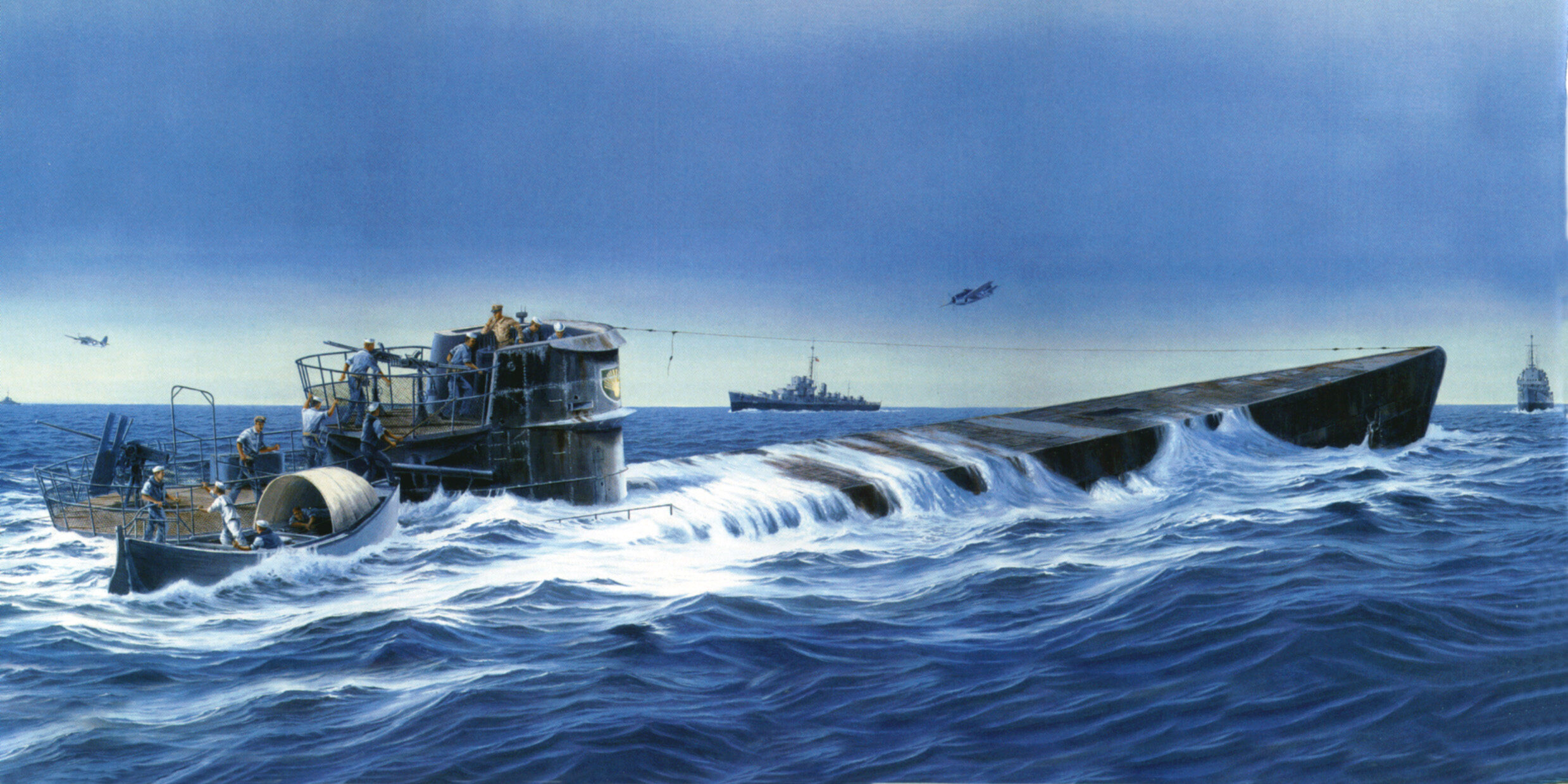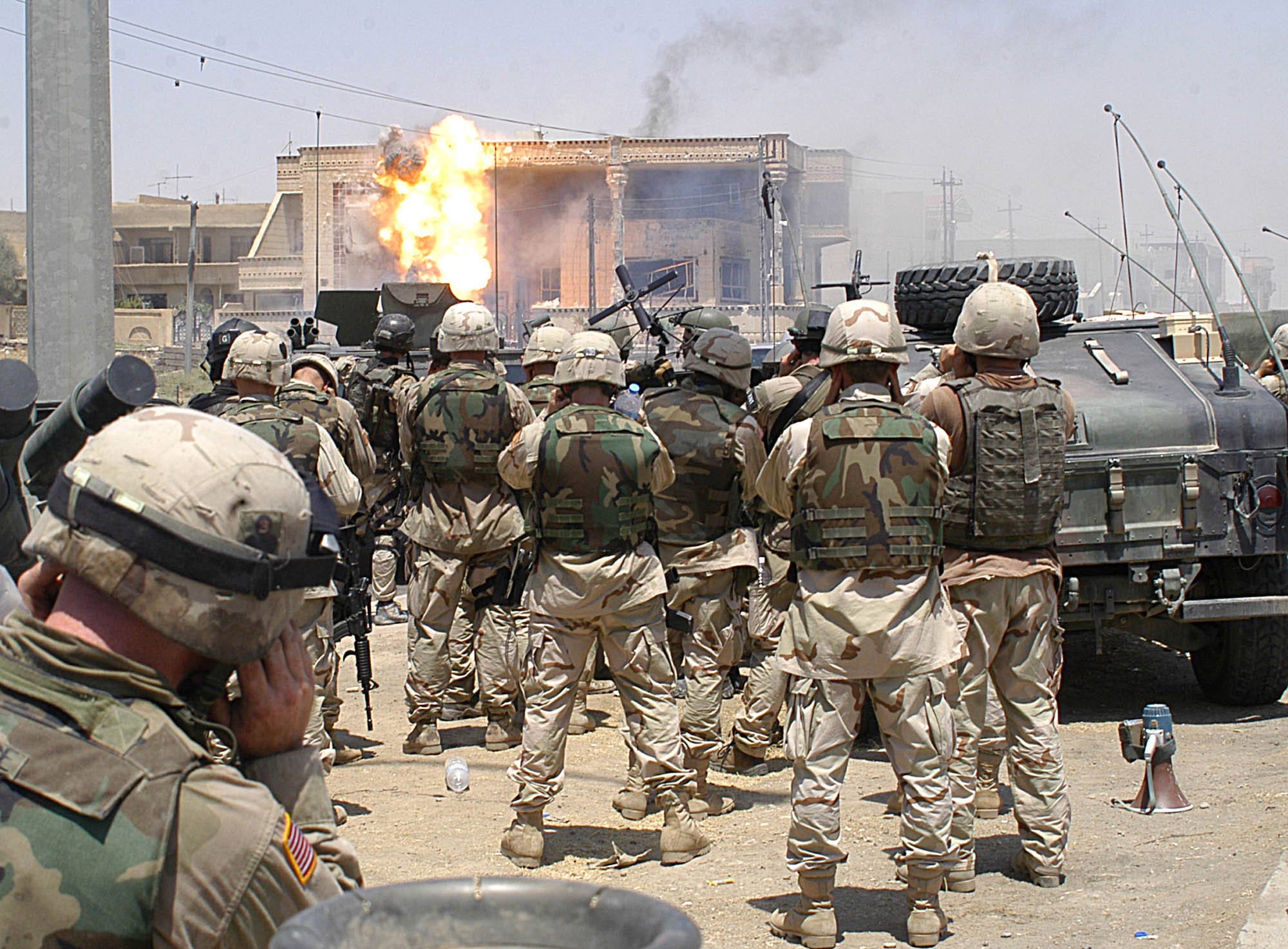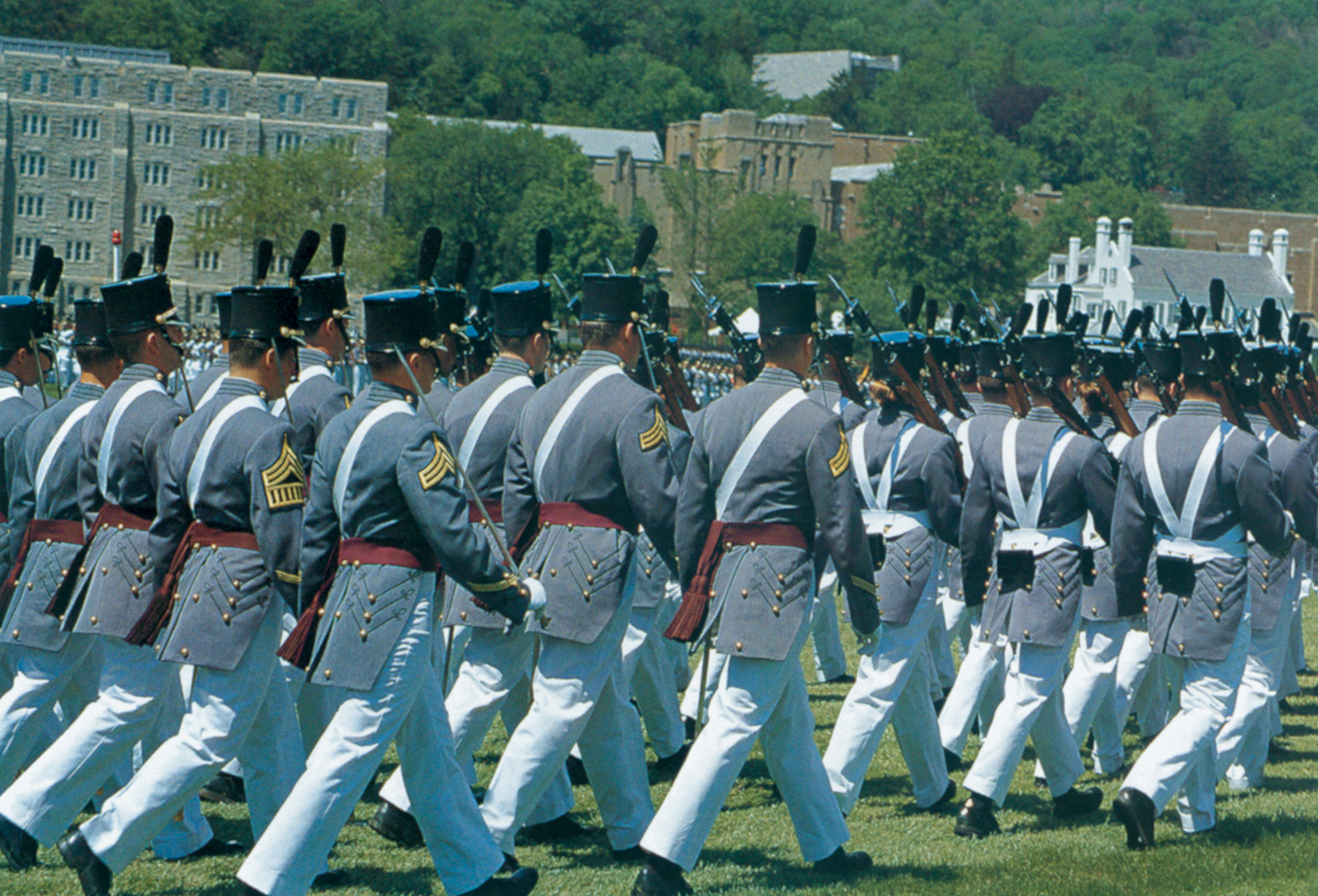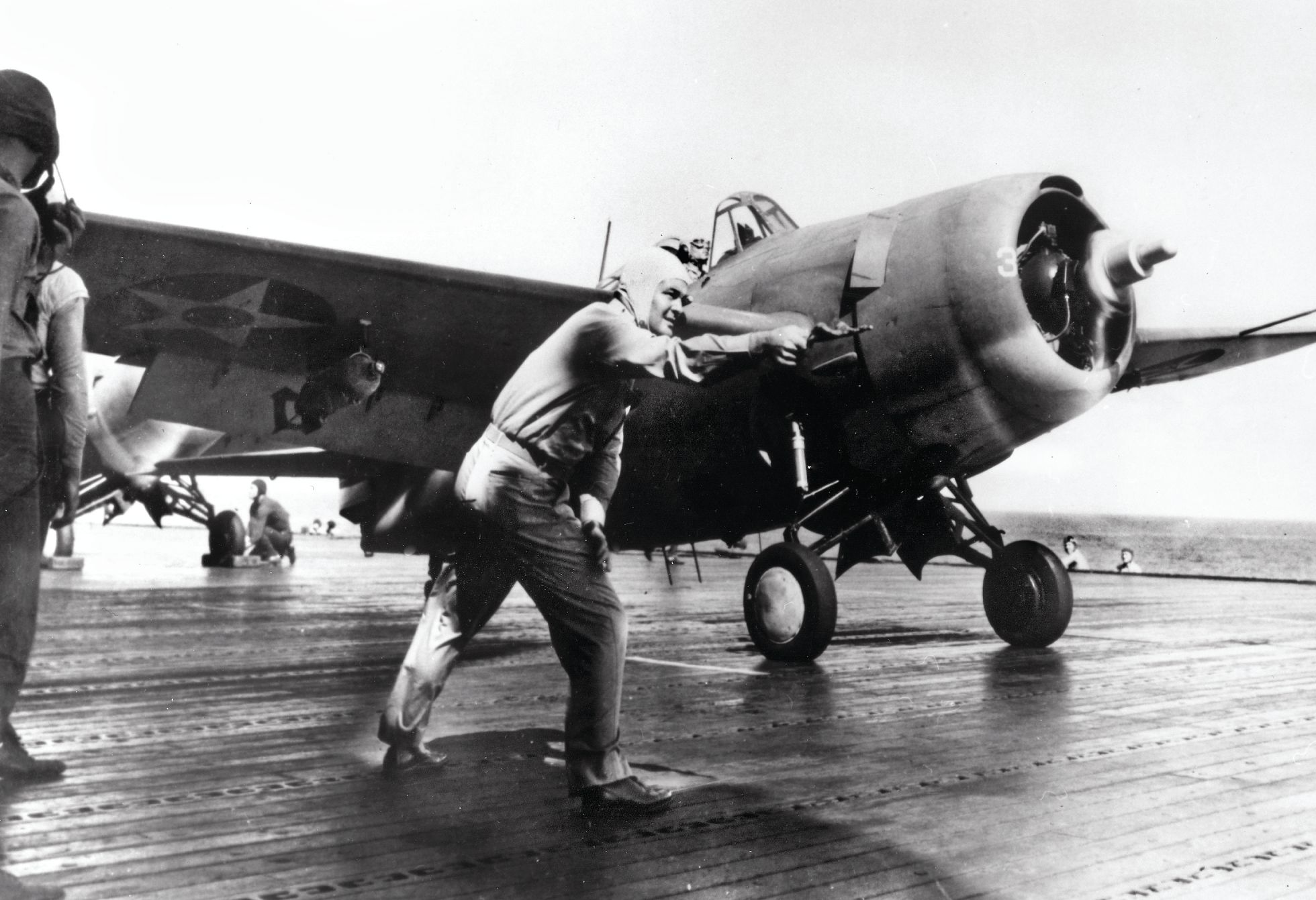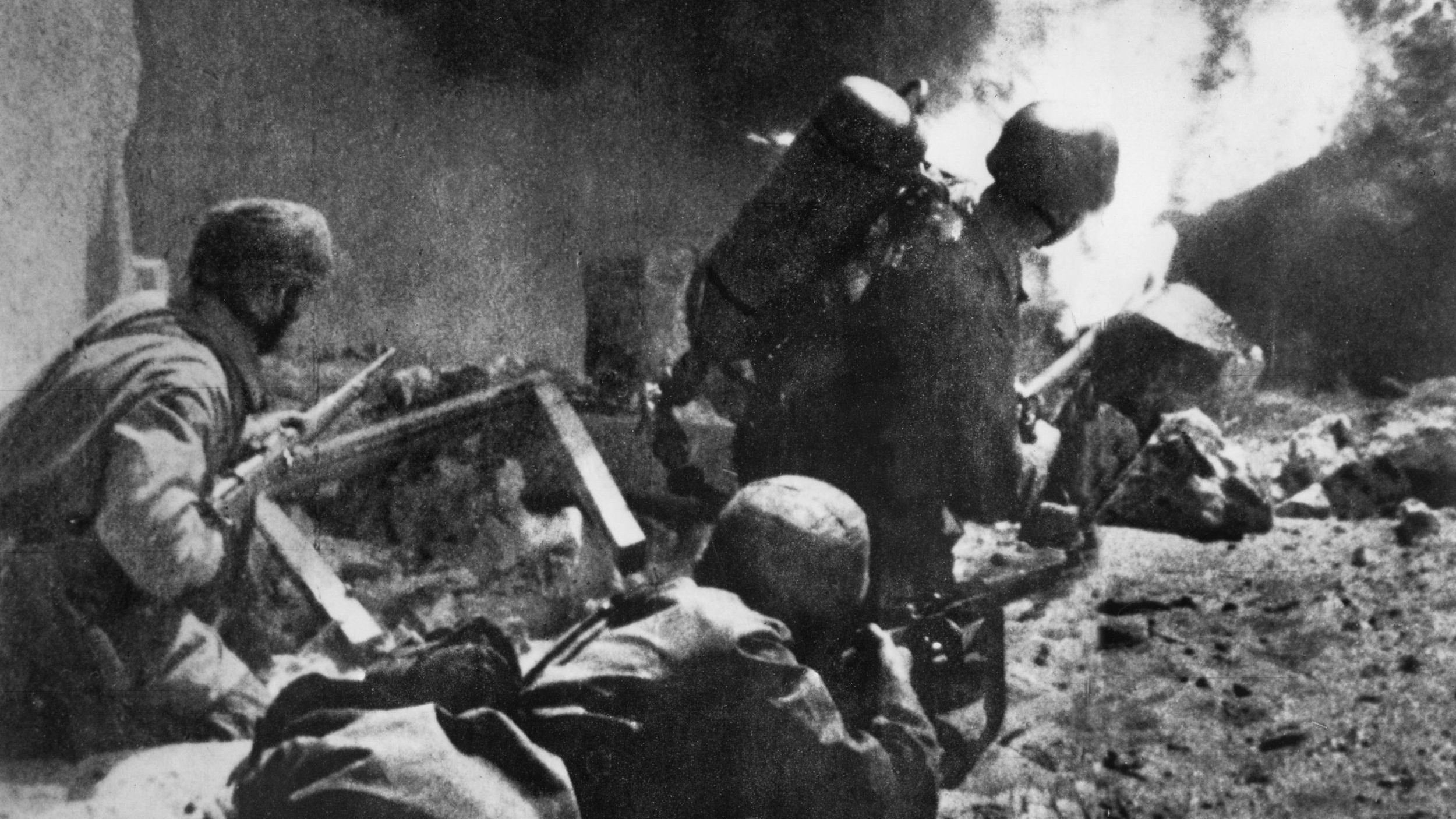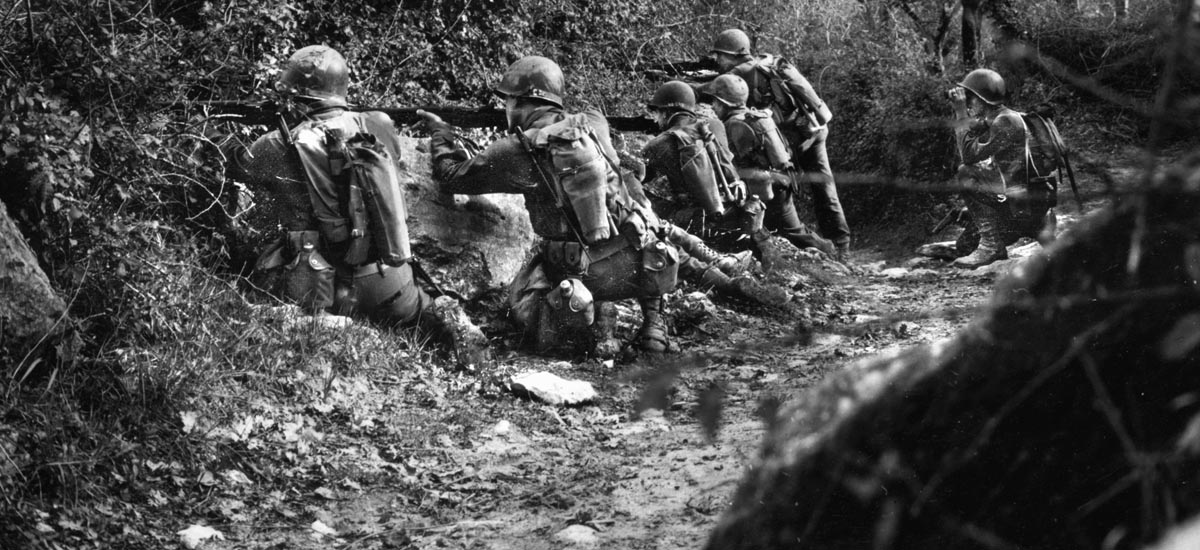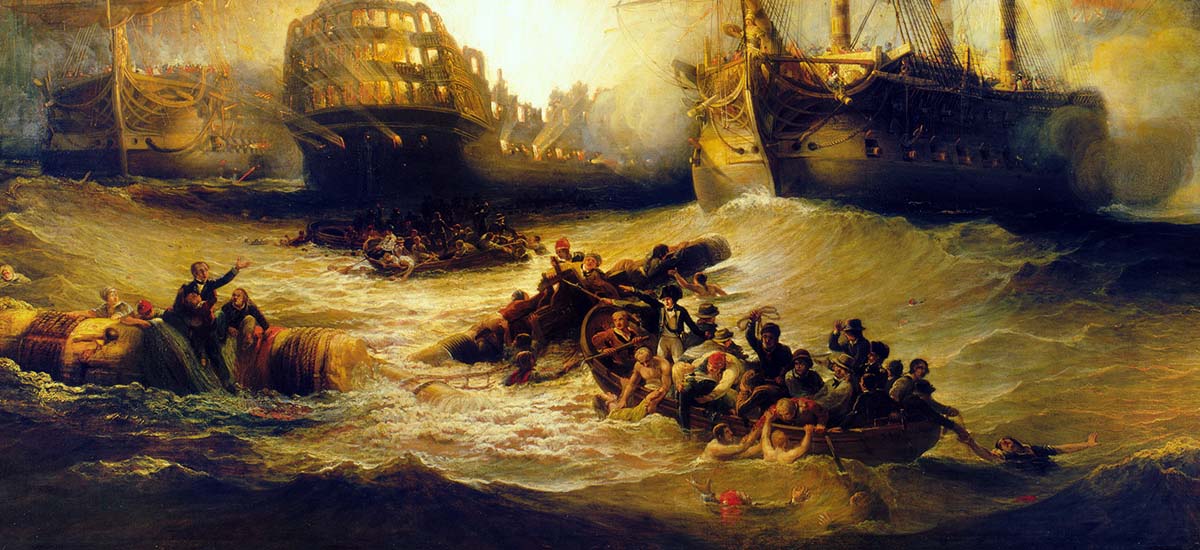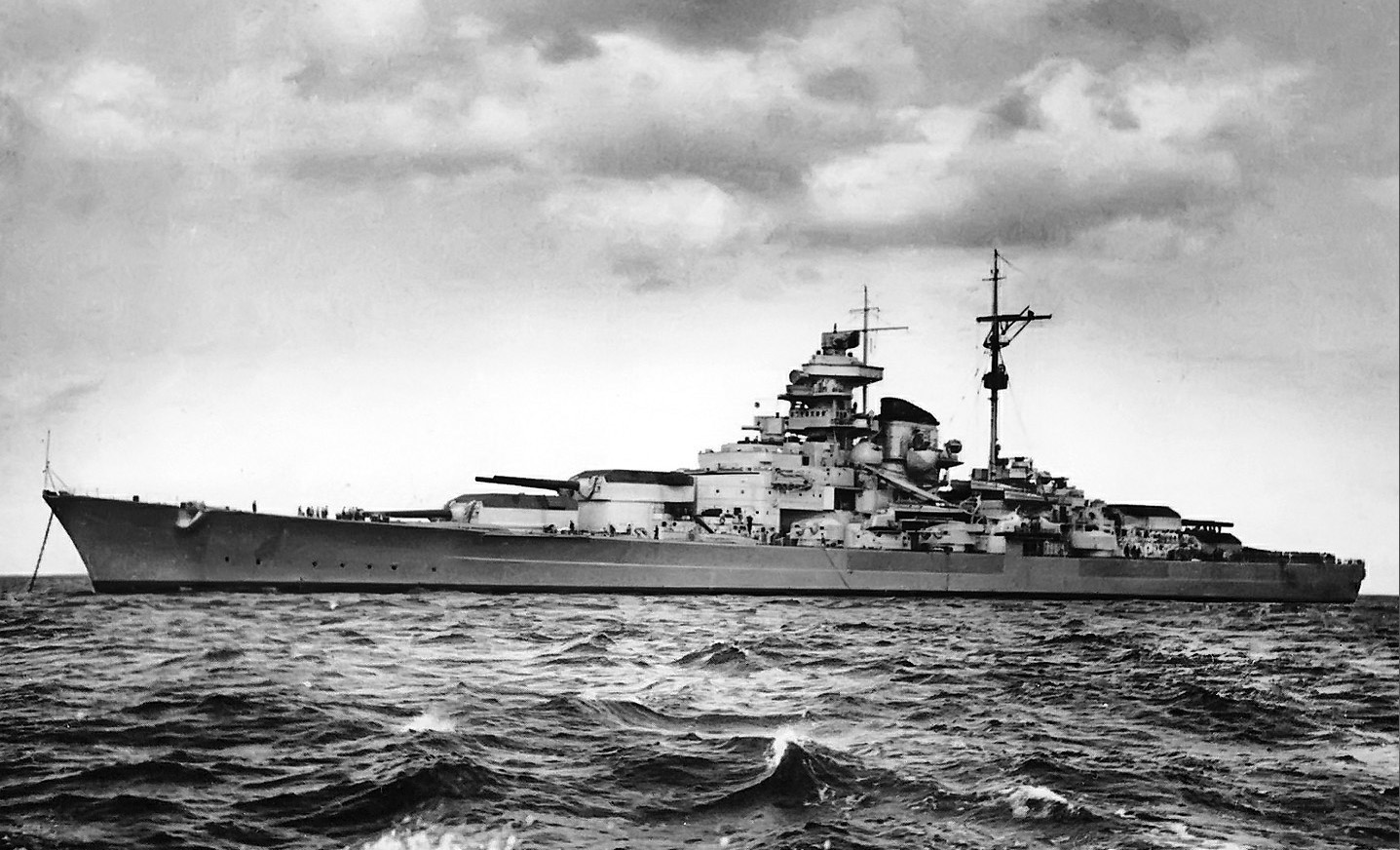By Christopher Miskimon
A black Opel automobile raced through the streets of Cologne, Germany, on March 6, 1945. The driver, 40-year-old Michael Delling, was making a run for it. Rather than stay in the city as American and German troops fought, he and his clerk, 26-year-old Katharina Esser, chose to run for the last remaining bridge to the east. Making his way through the rubble-strewn streets, Delling dashed into an intersection near the city’s famous cathedral. The split-second decision was fatal. Machine-gun fire tore into the car. Tracer bullets ripped through its thin metal shell and into the bodies of the two civilians. The car came to a stop; Deller was dead, slumped over the steering wheel, and Esser managed to open the passenger door before tumbling to the pavement.
 A few yards away American Corporal Clarence Smoyer released the trigger of the coaxial machine gun in his T26 Pershing tank. The car looked like a German Army staff car, so he fired on it. He had no idea who sat inside. A few blocks in the other direction, German tanker Gustav Shaefer peered through his Panzer IV’s sights. He saw the orange American-style tracers flashing through the intersection. Were the Americans coming? He had to be ready. A dark shape appeared, and the young tanker squeezed the trigger on his own coaxial machine gun. Green German tracers lashed out as well, smashing into the staff car and blowing out its windows. Gustav saw the woman fall out of the car and wondered what she was doing in a combat zone.
A few yards away American Corporal Clarence Smoyer released the trigger of the coaxial machine gun in his T26 Pershing tank. The car looked like a German Army staff car, so he fired on it. He had no idea who sat inside. A few blocks in the other direction, German tanker Gustav Shaefer peered through his Panzer IV’s sights. He saw the orange American-style tracers flashing through the intersection. Were the Americans coming? He had to be ready. A dark shape appeared, and the young tanker squeezed the trigger on his own coaxial machine gun. Green German tracers lashed out as well, smashing into the staff car and blowing out its windows. Gustav saw the woman fall out of the car and wondered what she was doing in a combat zone.
It was a terrible tragedy of war, an accident no one wanted but could not be avoided. It would haunt Clarence for decades, but that was for later; the war continued. A block away another German tank, a Panther, lay in ambush. The crew spotted a Sherman approaching and fired. The round struck squarely, knocking out the American tank. The high-velocity projectile severed the tank commander’s leg. He tumbled out of the hatch onto the Sherman’s engine deck but died a few minutes later in the rubble of Cologne. The Panther moved from its hiding spot to take up position in a square, ready to continue the fight.
Clarence and his crew sat in their Pershing less than 300 yards away. Their tank carried better armor and a more powerful gun than the Sherman. A combat cameraman caught the attack on film and then came back to the Pershing to ask for help destroying the Panther. Clarence’s tank commander, Sergeant Robert Early, went forward to scout the situation. Minutes later, the Pershing rumbled forward to engage the Panther at point-blank range.
The rest of this story is the climax of Spearhead: The World War II Odyssey of an American Tank Gunner (Adam Makos, Ballantine Books, New York, 2019, 385 pp., maps, photographs, notes, bibliography, index, $28.00, hardcover). The book shows the world of tank crewmen at the gunsight level as they struggle to fight and survive the dreadful conclusion of the war in Europe.
This new work is engaging and dramatic, giving the reader a sense of the strain and emotion of a tank crew manning one of the U.S. Army’s then-new Pershing tanks in early 1945. The author also covers how the crew got to that point along with the experiences of the armored infantrymen who accompanied them and the German tankers who opposed them. The book concludes by revealing how these men dealt with their memories postwar. It is also well illustrated. The writing is insightful and does an excellent job bringing the tanker’s war to light.
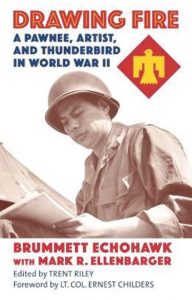 Drawing Fire: A Pawnee, Artist, and Thunderbird in World War II (Brummett Echohawk with Mark R. Ellenbarger, University Press of Kansas, Lawrence, 2018, map, illustrations, glossary, index, $29.95, hardcover)
Drawing Fire: A Pawnee, Artist, and Thunderbird in World War II (Brummett Echohawk with Mark R. Ellenbarger, University Press of Kansas, Lawrence, 2018, map, illustrations, glossary, index, $29.95, hardcover)
Brummett Echohawk joined the Oklahoma National Guard in 1940. His unit, the 179th Infantry Regiment of the 45th “Thunderbird” Infantry Division, mixed farmers, cowboys, and more than 1,000 Native Americans into a formidable American unit. Brummett and his comrades shipped overseas in the spring of 1943 and soon entered combat. The invasion of Sicily came first, followed by the ordeal of Salerno and the crucible of Anzio. The fighting proved difficult; Brummett lost many friends along the way, but he did justice to their memories by capturing their experiences on paper. Brummett was an artist, a skill gained at the Pawnee boarding school he attended as a boy. His combat sketches and portraits of soldiers drawn at a military hospital capture the sacrifice, courage, and suffering of the frontline soldier. Brummett had firsthand experience of this; he was not an official combat artist. Rather, he was an infantryman who often served as a scout for his company, a dangerous role fraught with risk.
This new work is part sketchbook and part memoir. Many of Brummett’s drawings are interspersed throughout the extensive text, which poignantly relates the reality of infantry combat. The text is straightforward and easy to follow, conveying its meaning effectively to the reader. There is emphasis on the experience of Native American soldiers, who made up a large portion of the unit, faced occasional prejudice, but proved themselves the equal of any soldiers on the battlefield.
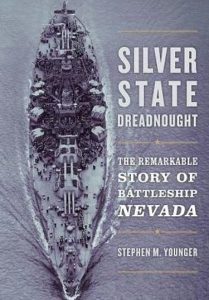 Silver State Dreadnought: The Remarkable Story of Battleship Nevada (Stephen M. Younger, Naval Institute Press, Annapolis, MD, 2018, 320 pp., photographs, notes, bibliography, index, $54.00, hardcover)
Silver State Dreadnought: The Remarkable Story of Battleship Nevada (Stephen M. Younger, Naval Institute Press, Annapolis, MD, 2018, 320 pp., photographs, notes, bibliography, index, $54.00, hardcover)
USS Nevada and the sailors who crewed her spent three decades in service to the United States. She was the first oil-fired American warship and the first to have three guns in a main turret. After convoy service in World War I and modernization in the 1920s, Nevada was at Pearl Harbor on December 7, 1941. She was the only battleship to get underway that day but was grounded and beached after receiving heavy damage. The Navy repaired the ship and sent her to the Atlantic, where she provided shore bombardment at D-Day and the invasion of southern France. Afterward, Nevada went back to the Pacific and served at Iwo Jima and Okinawa. Obsolete at the end of the war, the ship was used as a target in two atomic tests but survived both. Too radioactive to scrap, Nevada was towed near Oahu and used for target practice. After five days of shelling, she was still afloat; a torpedo finally sent her to a warrior’s death.
The author neatly tells the story of this proud warship. The stories of her crew combine with the ship’s history to show how the two blend to make a functioning warship. Any ship that serves for so long accrues a myriad of interesting tales and anecdotes; this book collects many interesting vignettes of Nevada’s service along with numerous photographs.
 The Soldier Who Came Back: The True Account of a Heart-Stopping Journey and a Heart-Breaking Decision (Steven Foster with Alan Clark, Mirror Books, London, UK, 2018, 288 pp., $15.95, softcover)
The Soldier Who Came Back: The True Account of a Heart-Stopping Journey and a Heart-Breaking Decision (Steven Foster with Alan Clark, Mirror Books, London, UK, 2018, 288 pp., $15.95, softcover)
Fred Foster was 24 when World War II began. In May 1939, he volunteered as a private in the 8th Battalion, Nottinghamshire and Derbyshire Regiment, known as the Sherwood Foresters. It was a reserve unit of Britain’s Territorial Army. When the war started that September, his unit became part of the 148th Infantry Brigade. In April his unit went to Norway to resist the German invasion, and Fred was captured. He and other prisoners were shipped to a POW camp in Poland. There, Fred met Captain Antony Coulthard, and the two became close friends. Soon they hatched an escape plan that took many months to put into action. They donned disguises and simply walked out of camp, using trains to travel west into Germany. After many adventures they reached the Swiss border, but only one of them made it across.
The journey and tragedy of these two young men is well told in this new book. Their different backgrounds and upbringing are explained before delving into how these men formed both their friendship and a daring escape plan. The prose flows clearly, making this work easy to read and quite engaging. It also has an emotional ending, which pulls readers in and keeps them involved until the story’s surprise conclusion.
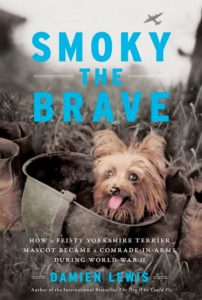 Smoky the Brave: How a Feisty Yorkshire Terrier Mascot Became a Comrade in Arms During World War II (Damien Lewis, Da Capo Press, Boston, MA, 2018, 320pp., photographs, $28.00, hardcover)
Smoky the Brave: How a Feisty Yorkshire Terrier Mascot Became a Comrade in Arms During World War II (Damien Lewis, Da Capo Press, Boston, MA, 2018, 320pp., photographs, $28.00, hardcover)
No one knew Smoky’s origin or her original home. A group of American soldiers found her in February 1944. The tiny Yorkshire Terrier huddled in an artillery-blasted foxhole, her fur matted and tangled around her frail, shivering body. The men took her in as GIs often do, back to the U.S. Army Air Forces airfield they manned. They were part of the 26th Photo Reconnaissance Squadron, tasked with missions deep behind Japanese lines. The little dog soon proved her worth. She barked a warning about enemy fire to Corporal William Wynne and saved his life. Smoky accompanied aircrews on their missions and even learned to jump using a specially designed parachute. The plucky little dog also dragged communications wire through a 70-foot pipe at a recently captured airbase, saving the men from having to brave incoming fire to do the work. Smoky was a lucky dog. She came home to celebrity after the war ended.
This book uses previously unpublished material to tell Smoky’s story. Her “missions” and assistance to young men far from home are covered in detail, providing the reader a fascinating story of a dog’s wartime adventures with her newfound friends. The prose is clear and relates the wider events of the war to the activities of the squadron and their mascot.
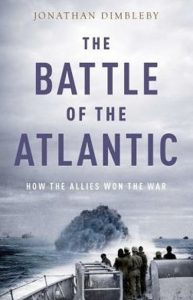 The Battle of the Atlantic: How the Allies Won the War (Jonathan Dimbleby, Oxford University Press, Oxford, UK, 2018, 530 pp., maps, photographs, notes, bibliography, index, $22.95, softcover)
The Battle of the Atlantic: How the Allies Won the War (Jonathan Dimbleby, Oxford University Press, Oxford, UK, 2018, 530 pp., maps, photographs, notes, bibliography, index, $22.95, softcover)
After the war, British Prime Minister Winston Churchill said the only thing that ever really frightened him was the menace of Nazi Germany’s U-boats. They came closer to defeating England than bombers, rockets, missiles, or panzers ever did. Most of England’s supplies came from the United States via merchant vessels, and those ships were targeted by wolf packs of deadly submarines. While intelligence services struggled to follow the German naval message traffic, shipyards turned out destroyers and sub-chasers by the hundreds alongside thousands of new cargo ships. Allied and Axis sailors and aircrews fought hundreds of battles vying for supremacy in the North Atlantic. The death rate, proportional to the number of people engaged, was the highest for either side in any theater during the war. In the end the Allies succeeded in abating the Nazi threat, allowing supplies and troops to pour into Europe and end the war.
Strategy mattered in the Battle of the Atlantic, and the author does a thorough job exploring and deciphering the myriad separate tasks carried out to bring the Allied plans to fruition. He also does excellent work describing the personalities who made that strategy successful through leadership and sheer endurance. The book is both informative and entertaining, using vivid descriptions to bring the action to life.
 The Battle of Arnhem: The Deadliest Airborne Operation of World War II (Antony Beevor, Viking Books, New York, 2018, 459pp., maps, photographs, notes, bibliography, index, $35.00, hardcover)
The Battle of Arnhem: The Deadliest Airborne Operation of World War II (Antony Beevor, Viking Books, New York, 2018, 459pp., maps, photographs, notes, bibliography, index, $35.00, hardcover)
Major Julian Cook led his men into the River Waal in flimsy canvas and wooden boats on September 20, 1944. The Germans waited on the other side, well dug in and prepared to defend the road bridge the Allies needed to continue their advance. Artillery and tanks blasted smoke rounds to cover the crossing, but the Germans knew something was coming. They fired mortars and machine guns into the haze, taking a fearful toll of the young American paratroopers. When the first wave of boats reached the far bank, the survivors climbed onto the shore amid a hail of bullets. The wounded and exhausted took cover; the able, angry and ready for revenge after their ordeal, formed into groups and attacked. The Germans were unprepared for the ferocity of the airborne men, who advanced shooting and throwing grenades. The Americans killed the German troops in their foxholes and stacked the bodies on the edges to provide cover while they caught their breath for the next push forward. Soon they overwhelmed the defense and seized the bridge and surrounding area, enabling British tanks to cross and continue their way to Arnhem, where more paratroopers were surrounded and awaiting relief.
There are many books telling the myriad stories of Operation Market Garden. This one stands out with its battlefield level detail, which places the reader squarely in the middle of the action. The author is well known and regarded for his previous works, which often cover the large, famous battles of the war in a way that makes them relatable to the audience. This work continues that tradition, delivering both narrative and detail.
 Desert Fox: The Storied Military Career of Erwin Rommel (Samuel W. Mitcham Jr., Regnery History, Washington, D.C., 2019, 460 pp., maps, photographs, appendices, notes, bibliography, index, $29.99, hardcover)
Desert Fox: The Storied Military Career of Erwin Rommel (Samuel W. Mitcham Jr., Regnery History, Washington, D.C., 2019, 460 pp., maps, photographs, appendices, notes, bibliography, index, $29.99, hardcover)
Erwin Rommel earned the sobriquet “Desert Fox” in dozens of battles across North Africa during World War II. When discussions of the conflict’s greatest generals arise, either Rommel or Patton are invariably mentioned. Rommel was known for his aggressiveness and daring, always seeming to push the British to the edge of their capacity or luring them into deadly ambushes. Despite this skill, he never managed to achieve a decisive victory. However, he did so in France, establishing his reputation and further burnished it in North Africa, but for all his efforts, the Axis was ultimately defeated there. Likewise, his preparations in France for the inevitable Allied invasion were formidable but failed to repulse the D-Day landings. The excuse is given that he and his fellow military leaders were hamstrung by Hitler and the Nazi Party, giving the impression he was robbed of his opportunities for victory. In the end even his life was stolen when he was forced to commit suicide in the aftermath of the July 1944 plot on Hitler’s life.
The complexities of Rommel are deftly explored in this new book. The author looks into the facts and myths surrounding the Desert Fox, his relationship with Hitler, and how he often tried to serve honorably under a regime bent on wickedness. The book is well illustrated with dozens of photos of Rommel, his soldiers, and those closest to him.
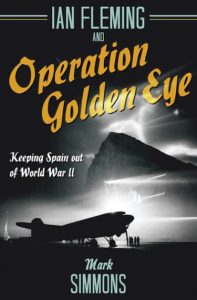 Glory in Their Spirit: How Four Black Women Took on the Army During World War II (Sandra M. Bolzenius, University of Illinois Press, Champaign, 2018, 256 pp., photographs, tables, notes, bibliography, index, $19.95, softcover)
Glory in Their Spirit: How Four Black Women Took on the Army During World War II (Sandra M. Bolzenius, University of Illinois Press, Champaign, 2018, 256 pp., photographs, tables, notes, bibliography, index, $19.95, softcover)
The U.S. Army during World War II was a segregated force. African Americans were allowed to join the services but extremely limited in the roles they could fill. Four of the young African American women who joined the Women’s Army Corps (WAC) did so to serve their country and show what their people could do for a nation that denied them full rights. In doing so, Mary Green, Anna Morrison, Johnnie Murphy, and Alice Young hoped to lay claim to those rights. Soon, however, they were assigned to orderly duties while white WACs received more skilled work and the opportunities that went with it. Unwilling to accept the situation, in 1945 they conducted a work strike along with 50 other WACs. The strike attracted media attention and ignited strong debates amid public uproar. The four women chose courts-martial rather than meekly returning to their prior duties. Patriotism, racism, and women in the military all became topics of discussion, pushed to the forefront by the bold but risky actions of these four WACs.
Little known today, the subject of this book is an episode that helped push the United States military down a road toward desegregation just a few years later. It is well researched and one of the first to look at the service and protest of African American enlisted women during the war. This work does justice to its topic.
 Air Combat: Dogfights of World War II (Edited by Tony Homes, Osprey Publishing, Oxford, UK, 2018, 320 pp., maps, photographs, bibliography, index, $35.00 hardcover)
Air Combat: Dogfights of World War II (Edited by Tony Homes, Osprey Publishing, Oxford, UK, 2018, 320 pp., maps, photographs, bibliography, index, $35.00 hardcover)
On March 18, 1945, the Corsair fighter-bombers of U.S. Marine squadron VMF-221 took off from the aircraft carrier USS Bunker Hill and flew to the Japanese mainland. They reached the island of Kyushu and attacked an aircraft factory near the town of Kumamoto. One after another they dove on the facility, firing rockets mounted on their gull-shaped wings. After shooting up the factory, the squadron turned east to return to its carrier and prepare for the next mission. On the way they ran into a formation of 25 Japanese fighters, scrambled from both the Imperial Army’s and Navy’s air forces to oppose the attacks on their homeland. The Corsair pilots attacked. Captain William Snider flew almost head on at his adversary. An experienced ace, Snider held his course until he almost collided with his opponent, setting the Japanese fighter aflame with machine-gun bursts. He dove on another, setting it afire as well, the enemy pilot bailing out. His wingman, Lieutenant Donald MacFarlane, shot down another plane. By the day’s end VMF-221 claimed 13 Japanese fighters downed. The tide had long ago turned against Imperial Japan.
Success in aerial combat for World War II pilots required training, skill, and daring. This new book takes four different clashes and shows how technical and human factors contributed to success or failure. The Spitfire vsersus the BF-109, Wildcat versus Zero, Soviet LA-5/7 versus FW190, and the Corsair versus the Ki-84 Frank are each given in-depth attention. The book is well researched, liberally illustrated, and written with clear prose.
 New and Noteworthy
New and Noteworthy
Shot Down and in the Drink: True Stories of RAF and Commonwealth Aircrews Saved from the Sea in World War II (Graham Pitchfork, Osprey Publishing, 2018, $15.00, softcover) This is a fascinating account of air-sea rescue during the war. It covers situations from different theaters of the war.
Heroes of Telemark: Sabotaging Hitler’s Atomic Bomb, Norway 1942-44 (David Greentree, Osprey Publishing, 2018, $20.00, softcover) The Norsk Hydro Plant in Telemark made heavy water for the Nazi nuclear program. This is the story of the Anglo-Norwegian mission to destroy the plant.
With Rommel in the Desert: Tripoli to El Alamein (David Mitchelhill-Green, Pen and Sword Books, 2018, $22.95, softcover) This photobook contains hundreds of photos of Rommel and his troops in the North African desert. It mixes battlefield scenes with images of everyday life for the soldiers.
Sam Goudsmit and the Hunt for Hitler’s Atom Bomb (Martijn van Calmthout, Prometheus Books, 2018, $24.00, hardcover) Goudsmit was a leading Dutch-American physicist. He helped in the search for the Nazi nuclear weapons program.
The Greatest Treasure Hunt in History: The Story of the Monuments Men (Robert M. Edsel, Scholastic Inc., 2018, $18.99, hardcover) The Monuments Men scoured Europe to save priceless art from the Nazis. This book tells their story for younger readers.
The Escape Line: How the Ordinary Heroes of Dutch-Paris Resisted the Nazi Occupation of Western Europe (Megan Koreman, Oxford University Press, 2018, $29.95, hardcover) The Dutch-Paris escape line funneled 1,000 people to safety from Nazi oppression. This new book gives it well-deserved recognition.
 Mussolini and Hitler: The Forging of the Fascist Alliance (Christian Goeschel, Yale University Press, 2018, $30.00, hardcover) This comprehensive study of the two Fascist leaders argues Mussolini had more influence over the relationship than is generally acknowledged.
Mussolini and Hitler: The Forging of the Fascist Alliance (Christian Goeschel, Yale University Press, 2018, $30.00, hardcover) This comprehensive study of the two Fascist leaders argues Mussolini had more influence over the relationship than is generally acknowledged.
Ian Fleming and Operation Golden Eye: Keeping Spain Out of World War II (Mark Simmons, Casemate Publishing, 2018, $32.95, hardcover) Ian Fleming, future author of the James Bond books, plotted to keep both Spain and Portugal out of the war. The complex plans to do so are covered in detail in this new work.
Hitler’s Death: The Case Against Conspiracy (Luke Daly-Groves, Osprey Publishing, 2018, $22.00, hardcover) The author argues Hitler died of suicide and rejects the various conspiracies surrounding his last days. He uses academic principles and existing evidence to argue his case.
The Gestapo’s Most Improbable Hostage (Hugh Mallory Falconer, Pen and Sword Books, 2018, $39.95, hardcover) This memoir covers the author’s time as a prisoner of war. He served in the Special Operations Executive before his capture.
